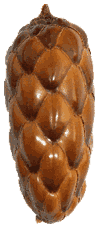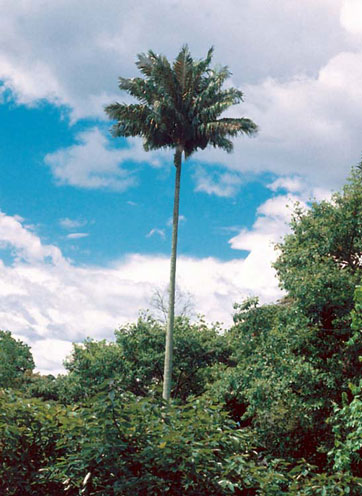 |
Palm |
 |
Palm |
Ceroxylon sasaimae is endemic to a very small area on the Western slope of the Cordillera Oriental, Cundinamarca Department, in central Colombia, at elevations between 1400 and 1800 m, which corresponds to the wet premontane life zone. The area was deforested more than 60 years ago to establish coffee plantations, and lately it is dedicated to coffee and fruit plantations and to resort farms.
Dioecious palm. Stem solitary, up to 20 m tall and 20–30 cm in diameter, gray to brown. Crown dense and almost globose, with 18–27 leaves, petiole absent or very short, rachis 2–3 m long, with 93–110 pinnae on each side, arranged in groups of 2–6, all pinnae rigid up to the apex, slightly disposed in several planes, olive green above, whitish below. Inflorescences several simultaneously, hanging in fruit, 2–3 m long, with many flexuous rachillae; flowers whitish, 5–7 mm long, the male ones with 9–10 stamens. Fruits ca. 4000–7000 per infructescence, globose, 1.5–1.8 cm in diameter, smooth, red to orange red when mature; seeds globose, smooth and brown, 1.2–1.5 cm in diameter.
There is not much information on the natural history of Ceroxylon sasaimae. It grows very well among the coffee plantations and produces flowers and abundant fruits. An adult palm produces an average of about 7.5 leaves per year (Rudas 1998). Seed germination occurs between six to 12 months, and first reproduction begins when the palm is 18–22-years old (Rudas 1998). It has been recorded with flowers in June, August and October and with mature fruits in April to June. The fruits are said to be consumed by several bird species of the region.
 |
| Ceroxylon sasaimae growing in coffee plantation. Photo by Gloria Galeano. |
It is estimated that the total population is about 100 adult individuals that survive in coffee plantations and resort farms. Considering that it is a dioecious palm, the effective size of the population is estimated in about 50 mature individuals. The adults have an abundant fruit production, but the seedlings are usually cut off or trampled when the plantations are cleared (Galeano 1995, Rudas 1998). Additionally, the area of its potential distribution is almost completely transformed into agricultural systems, and the possibilities to find it in forest remnants are very scarce. The young leaves of the palms used to be cut for use during Easter Sunday, but this practice is almost abolished.
Based on the above mentioned situation, Ceroxylon sasaimae has been considered Critically Endangered (CR), using the criteria D1 (small population), following the IUCN (2001) (Galeano & Bernal 2005).
During the last few years, a campaign to protect this species has been organized. The adult palms are protected, and several peasant farmers are cultivating the species to sell the seedlings and the juvenile palms to the resort farms of the region. The species is also cultivated in the botanical garden in Bogotá and in several private collections in central Colombia.
The origin of this species is enigmatic, and more exploration of all the forest remnants in the area (if any exist!) is greatly desired, along with more information about the history of the species in the region. It is also necessary to study its natural history, pollination, seed dispersion and gene flow. It is important to give support to the present individual initiatives to protect and cultivate the species in the area, as well as to promote its cultivation in other botanical gardens in Colombia.
Gloria Galeano, Instituto de Ciencias Naturales, Universidad Nacional de Colombia, Sede Bogotá, Colombia.
Galeano, G. & R. Bernal. 2005.
Palmas. Pp. 59–224.
En: Calderón, E., G. Galeano & N. García (eds.).
Libro Rojo de Plantas de Colombia. Volumen 2: Palmas, Frailejones y Zamias.
Serie Libros Rojos de Especies Amenazadas de Colombia. Bogotá, Colombia.
Instituto Alexander von Humboldt-Instituto de Ciencias Naturales de la Universidad nacional de Colombia- Ministerio de Ambiente, Vivienda y Desarrollo Territorial.
IUCN. 2001.
IUCN Red List Categories: Versión 3.1.
Prepared by the IUCN Species Survival Commission.
IUCN, Gland, Switzerland and Cambridge, UK.
Rudas, C. 1998.
Evaluación del estado actual de una población de la palma de cera, Ceroxylon sasaimae Galeano:
aportes a su historia de vida y estudio demográfico.
Tesis de grado para optar al título de Bióloga, Departamento de Biología, Facultad de Ciencias, Universidad de Los Andes, Bogotá.